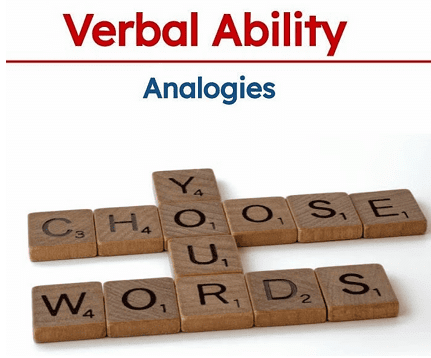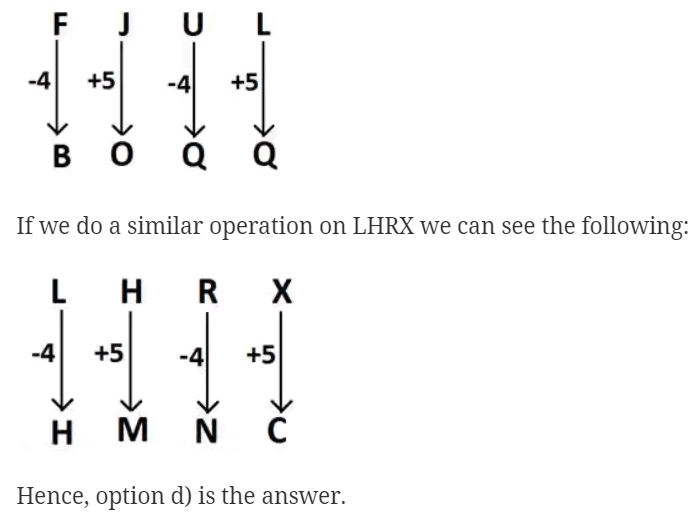How to Solve Analogies: Vocabulary | General Aptitude for GATE - Mechanical Engineering PDF Download
| Table of contents |

|
| Introduction |

|
| Types of Analogies |

|
| Three-Step Bridge Method for Solving Analogies |

|
| Solved Questions |

|
Introduction

- Questions involving analogies ask to find the relationship between the pairs of words.
- The relationship between the words in the question asked is similar (or dissimilar) to the options, you have to find out the correct option.
Types of Analogies
1. Completing Analogous Pair
Such questions give the relationship between a pair; first element of second pair is given, and we have to find the second element of the second pair based on a similar relationship given by the first pair.Example:
Oasis: Sand ∷ Island:?
(a) River
(b) Sea
(c) Water
(d) Waves
How to Think: Imagine an oasis surrounded by sand. What surrounds an island? Water! The analogy is about surroundings.
Correct Answer is Option (c).
Here, the first pair is ⇒ “Oasis: Sand” and the second pair is “Island:?”. And, “∷” sign means first pair and second pair share similar relationship. ‘Oasis’ is a mass of water amidst 'Sand ’; similarly ‘, Island’ is a mass of land amidst ‘water
2. Simple Analogy
In such questions, a simple statement is given where a relationship is given and we’re asked the second element for the term given in the question, like the example below:Cold is to Ice as Hot is to...
(a) Steam
(b) Water
(c) Snow
(d) Rain
How to Think: Cold leads to the formation of ice, just like heat leads to the formation of steam. It's a cause-and-effect relationship based on temperature-induced state changes.
Correct Answer is Option (c).
3. Choosing the Analogous Pair
In such questions, a pair is given in the question, and we've got to find a suitable pair from the options given that resembles the similar relationship as in the question, like the examples below:
Borrow : Steal
(a) Enter: Trespass
(b) Tell: Speak
(c) Ask: Beg
(d) Hit: Kill
How to Think: Both involve taking something, but one with permission, the other without. Similarly, among all the options, we see this option is seen in ‘Enter: Trespass’ where we ‘enter’ after taking permit while ‘trespassing’ is done without any permit whatsoever.
Correct Answer is Option (a).
4. Multiple Word Analogy
These are the types of questions discussed above, with the only difference being that here, three elements are given in a pair instead of two, and we have to select the suitable option. Like the example below:
Music: Guitar: Performer
a) Dance: Tune: Instrument
b) Food: Recipe: Cook
c) Patient: Medicine: Doctor
d) Trick: Rope: Acrobat.
How to Think: In, Music: Guitar: Performer, ‘Performer’ plays ‘Music’ on ‘Guitar’. So, III element is playing/doing I element on II element.
From options, we can clearly see that this pattern is followed only in option d) i.e. Acrobat (An athlete who performs acts requiring skill) performs ‘Tricks’ on a ‘Rope’.
Correct Answer is option (d).
5. Number-based Analogy
Till now, we saw the analogy based on words; now we've got questions based on numbers too, like shown below:
Choose the analogous pair:
7 : 24
(a) 20 : 100
(b) 23 : 72
(c) 19 : 58
(d) 8 : 35
Correct Answer is option (b).
6. Alphabet-based Analogy
In these types of questions, two words that are groups of random letters are related to each other in some way. We’re supposed to complete the analogous pair based on that relationship:
FJUL: BOQQ∷ LHRX: ?
(a) BKPR
(b) MNCC
(c) HRYY
(d) HMNC
Correct Answer is option (d).
The relationship between FJUL: BOQQ can be illustrated as:
7. Mixed Analogy
These types of questions mixed alphabet and number, like shown below:
T/J : 2 :: X/H : ?
(a) 2
(b) 3
(c) 4
(d) 5
The given analogy is T/J : 2 :: X/H : ?
Step 1: Understanding the given ratio (T/J = 2)
- T is the 20th letter in the alphabet.
- J is the 10th letter in the alphabet.
- The ratio is calculated as:
- 20 ÷ 10 = 2
Step 2: Applying the same logic to X/H
- X is the 24th letter in the alphabet.
- H is the 8th letter in the alphabet.
- The ratio is:
- 24 ÷ 8 = 3
Thus, the correct answer is (b) 3.
Three-Step Bridge Method for Solving Analogies
Step 1: Build a strong bridge (relationship) sentence relating the words in the question pair. The bridge should be as short and clear as possible.
Step 2: Use this bridge with each answer choice, inserting them in place of the words in the question pair.
Step 3: The answer will be the sentence that is the most logical. If after completing steps 1 and 2, you still have not found the answer pair that works, it may be necessary to adjust the bridge sentence.
Example 1: Bad : Terrible
(a) hard : difficult
(b) hot : warm
(c) funny : hilarious
(d) right : wrong
(e) young : new
Correct Answer is Option (c).
Something that is extremely bad is terrible. Something that is extremely funny is hilarious.
Example 2: Candy : Sweet
(a) man : strong
(b) time : fast
(c) money : powerful
(d) movie : exciting
(e) fire : hot
Correct Answer is Option (e).
A characteristic of a candy is to be sweet. A characteristic of a fire is to be hot.
Example 3: Finger : Hand
(a) ball : game
(b) clock : room
(c) wheel : car
(d) hat : suit
(e) man : woman
Correct Answer is Option (c).
A finger is part of a hand. A wheel is part of a car.
Solved Questions
Q.1. Human : Lip :: Bird : ?
(a) Bush
(b) Grass
(c) Forest
(d) Beak
Relationship: Humans use lips to drink or eat something. Similarly birds collects grass with the help of beak to make her nest.
Correct Answer is Option (d)
Q.2. Flow : River :: Stagnant : ?
(a) Rain
(b) Stream
(c) Pool
(d) Canal
Relationship: As Water of a River flows similarly water of Pool is Stagnant.
Correct Answer is Option (c)
Q.3. Paw : Cat :: Hoof : ?
(a) Lamb
(b) Elephant
(c) Lion
(d) Horse
Relationship: As cat has Paw similarly Horse has Hoof.
Correct Answer is Option (d)
Q.4. Ornithologist : Bird :: Archaeologist : ?
(a) Islands
(b) Mediators
(c) Archaeology
(d) Aquatic
Relationship: As Ornithologist is a specialist of Birds similarly Archaeologist is a specialist of Archaeology.
Correct Answer is Option (c)
Q.5. Peacock : India :: Bear : ?
(a) Australia
(b) America
(c) Russia
(d) England
Relationship: As Peacock is the national bird of India, similarly Bear is the national animal of Russia.
Correct Answer is Option (c)
|
206 videos|190 docs|158 tests
|
FAQs on How to Solve Analogies: Vocabulary - General Aptitude for GATE - Mechanical Engineering
| 1. What are the different types of analogies and how can I identify them? |  |
| 2. How can I effectively use the Three-Step Bridge Method for solving analogies? |  |
| 3. What strategies can I use to improve my vocabulary for analogies? |  |
| 4. How can I approach multiple word analogies effectively? |  |
| 5. What are some common mistakes to avoid when solving analogies? |  |























